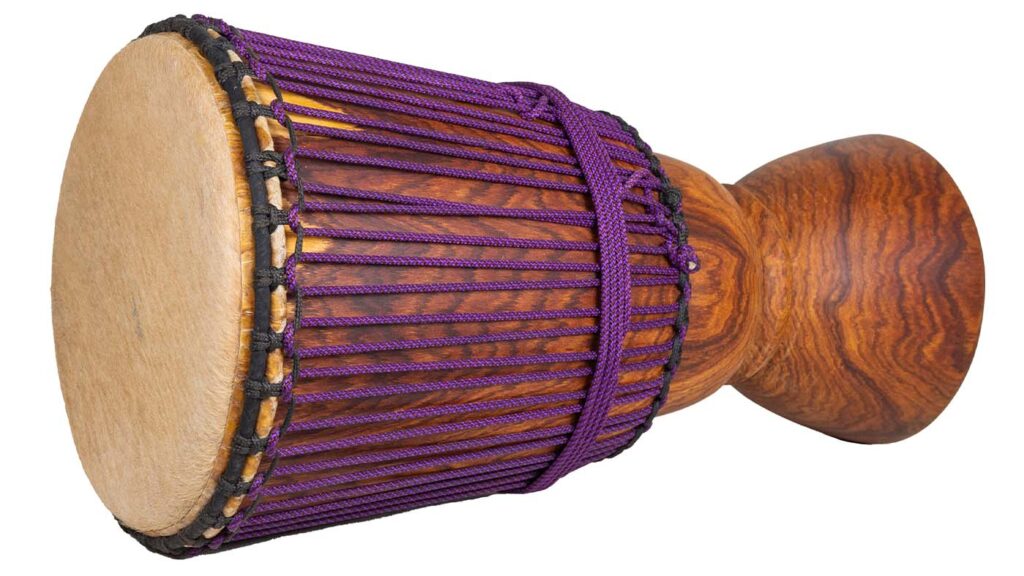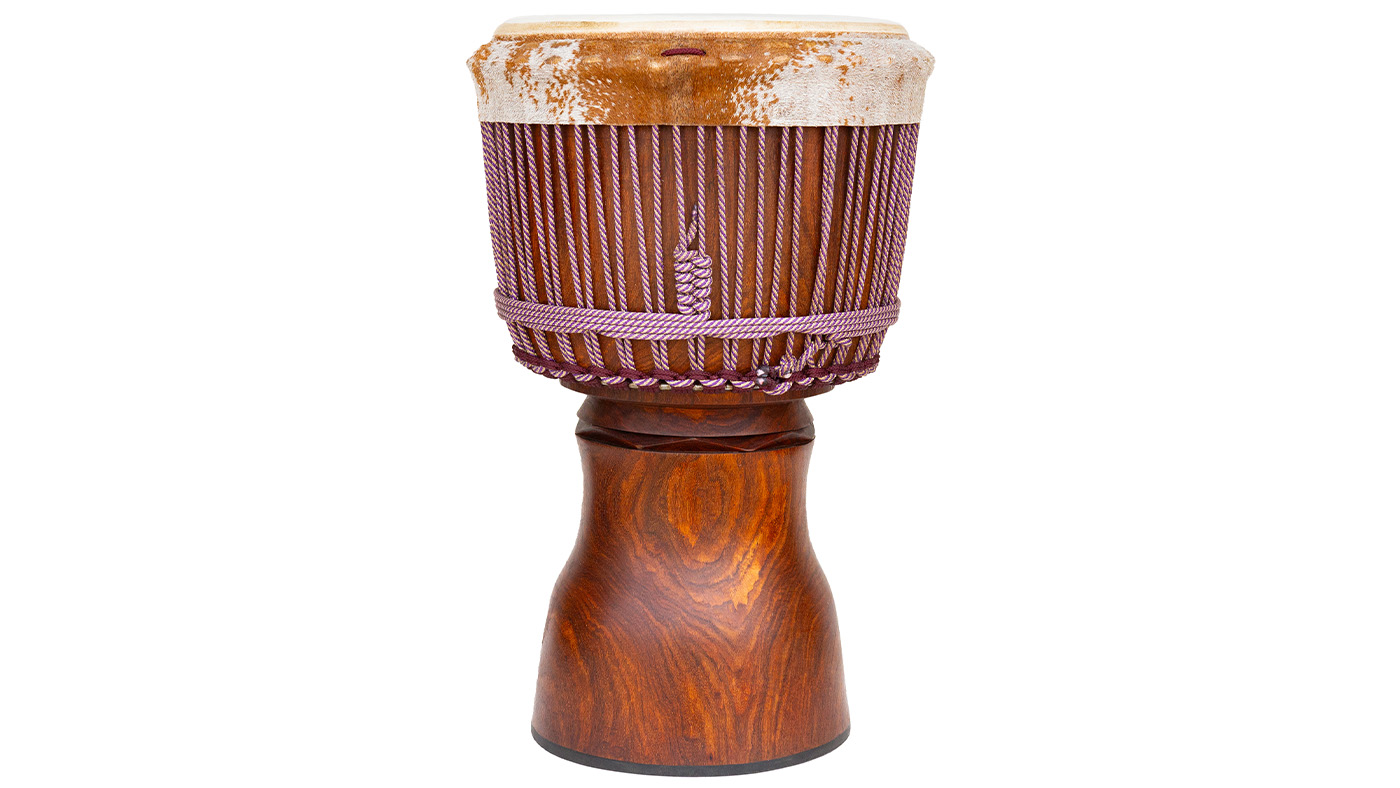How to choose the best djembe.
Many people write to me all the time and ask, “what djembe should I buy? And I often get asked, “please help me choose a djembe”. The best djembe is the drum that is perfect for your needs. Everyone needs something a little different and some people do not need or want a professional drum where as some people want the highest quality musical instrument they can get.
I do suggest whatever you need is that you do make sure you get high quality. Built well. Built to last. And it should sound good. Why buy something that does not sound good or is not built well? Many people buy drums that are cheap, only to end buying another better drum later and being stuck with the first drum.
About djembes
Please note that the djembe drum is indeed a musical instrument from a long, deep rooted heritage and for the most part, (especially in the higher end models), are made by very experienced crafts people who have trained long and hard and are very skilled at what they are doing.
Making a djembe is an art form and several different sets of hands are involved in the process.
A djembe drum is a fine musical instrument. Just like a piano maker or guitar. Djembe artisans work with wood, skin, metal, rope and other elements to create something beautiful for you to create music on.
A drum is not a lesser instrument then any other instrument . Just as much or more time goes into the making of a good drum as any other instrument. Try carving a shell with rudimentary hand tools and mounting a skin for yourself if you want to really know.
So please keep in mind that there is a huge process that goes into the making of your drum. A tree must be grown/ found, cut, aged, carved on the outside by hand and also on the inside. Rings must be made and welded.
Skins must be obtained and processed. The shell gets further decorative carvings and treatment. The skin gets mounted and pulled. No easy job and getting it right and balanced is an art unto itself. All of these things take skills. There is very little margin for error in high quality and professional drums. Everything must look right, feel right and sound right, too1

The first thing
I ask someone who asks me to make a recommendation for a drum is what is there intention with the drum?
Are you going to jam, play at dance classes, perform, record, go to drum circles or play in the band?
If you are jamming with friends you might not need the loudest or heaviest drum. If you are playing acoustic music you might want a larger drum with more mid range, tone and a thicker less ringy skin.
Each drum size, type, wood and shape can effect your playing experience. Of course your own playing technique is a big factor as well, but that is another story.
The bright slap may be less important for recording drums. At a drum circle you may want a mid sized light weight drum with a balanced sound and possibly a thinner skin so you project more and have more bass. Or maybe you want to stand out so you may want a louder and larger drum.

People often say, “I want a lot of bass”. The bass is more about the relationship of skin to shell then the size, weight, shape or type of wood used. However the bowl shape and stem opening as well as the length of the stem can have something to do with it as well.
Often thinner skins have more bass, less defined tone and sharper slaps. Its harder for many people to differentiate slap and tone on thin skins. These days most people prefer and use medium thick to thick skins when using goat.
How do you play?
An important question to ask yourself about a potential drum is, are you carrying the drum around, traveling far and playing sitting up or standing? If you are going to stand the weight is important.
In this case of course you want a lighter drum. And often a lighter drum is a compromise in sound. So you have to decide for yourself what are the most important factors.
Many people use djembe stands that hold the drum in the air slightly off the drum so there is no pressure on their backs. They can be nice if properly made and heavy duty, I have not found one that
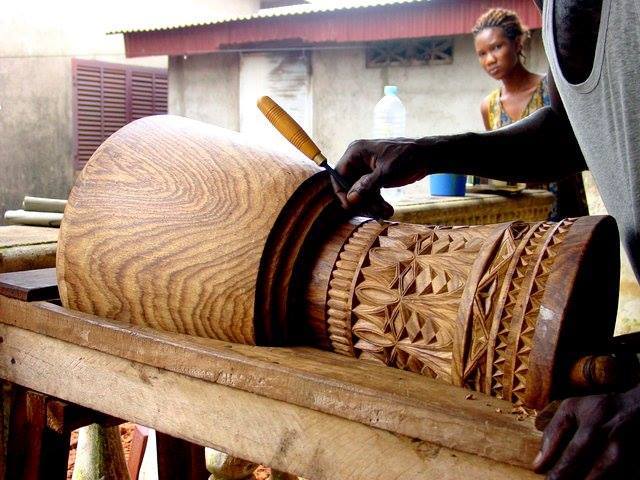
does not jiggle and move. This may also be do to my particular playing style.
Occasionally smaller and lighter drums can sound as good as larger drums. But not usually and there are no “givens”. And it’s not science.
Overtime, sometimes I think I finally have the formula down of what makes a drum sound a certain way. And then a drum will appear and go against everything I have thought I learned and said. So I am going to say “generally speaking” and “for the most part” when I talk about all of these factors that one has to consider when buying a djembe drum.
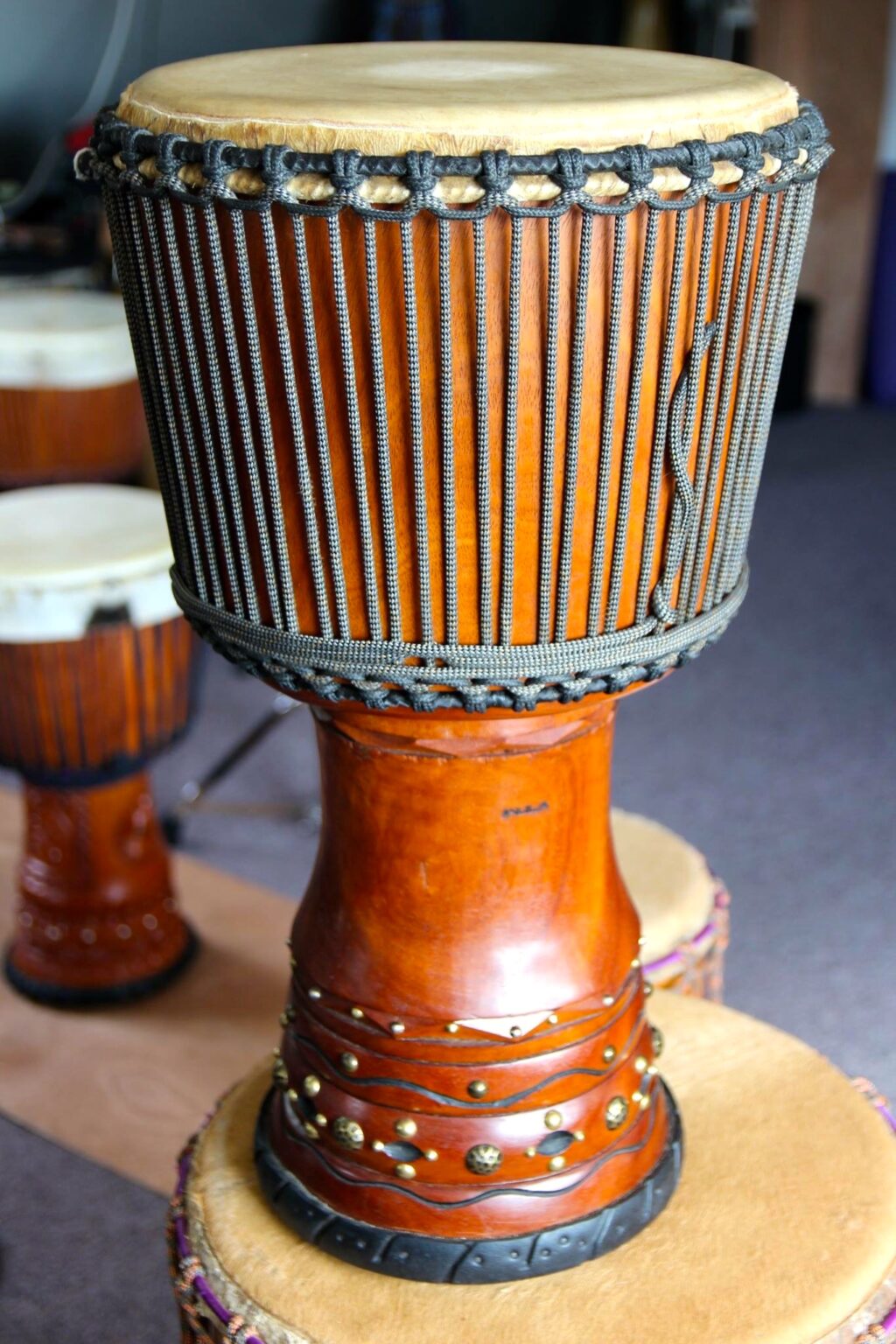
Wood and weight
To my ears and in my personal experience heavier drums tend to sound better then lighter drums for over all balanced sound.
But who wants to be standing up playing for an hour with a super heavy drum? Of course you can always put it in a stand as an option.
The reason heavier, thicker or harder woods sound better is because I think that the thicker would resonates more, The same is true on conga drums. The thicker and denser harder woods always sound better.
Lenke (lengue), Hade (Khadi), are two examples of hardwoods that are commonly found on high end drums from Guinea and Mali. Some people like Djalla wood. Some people like other woods.
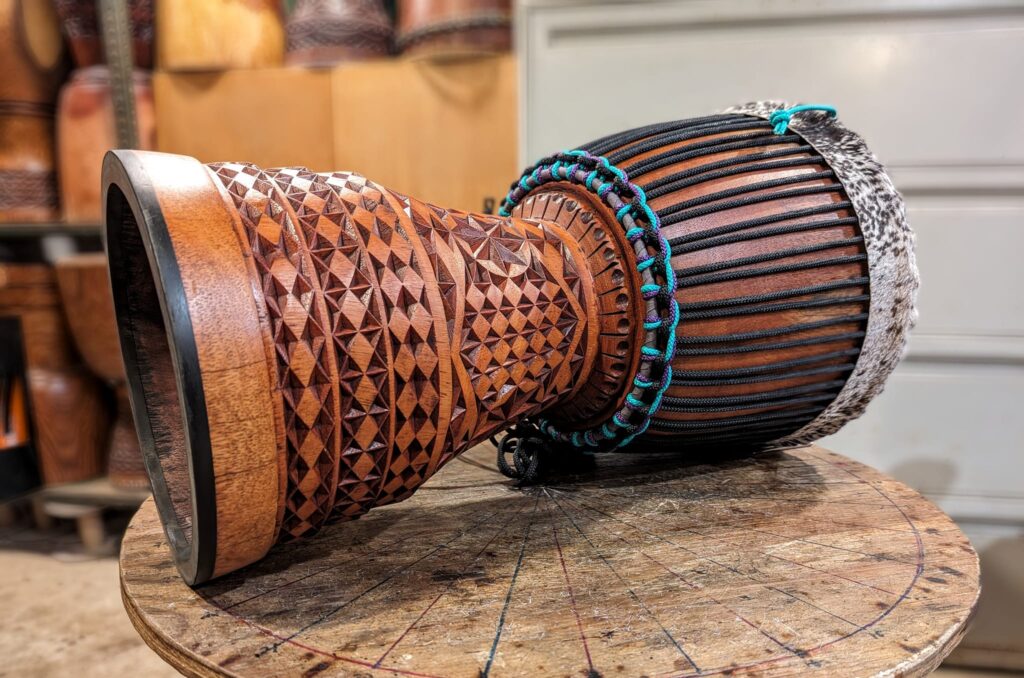
Senegal often has a hard wood called Dimba which is not as pretty as the two aforementioned wood but quite resonant as well. It is the first wood I personallyencountered in the late 70’s prior to the arrival of Guinea products in my area California.
The Ivory Coast often uses Iroko wood which is a lighter less dense wood but still produces a nice sound. They also have access to many other woods as well bu in the past this has been their mainstay.
There are so many other woods to be found as well. Ghana uses an inexpensive very light weight wood called Tweenaboa.
When it’s used to make very thick shells, if it is heavy and when it has a medium to thick skin on it (I recommend calf) it can sound very nice. But the cheap, light Ghana drums with thin heads and thin skins don’t sound good to my ear, anyway. However, having said that they have been improving steadily over the years.
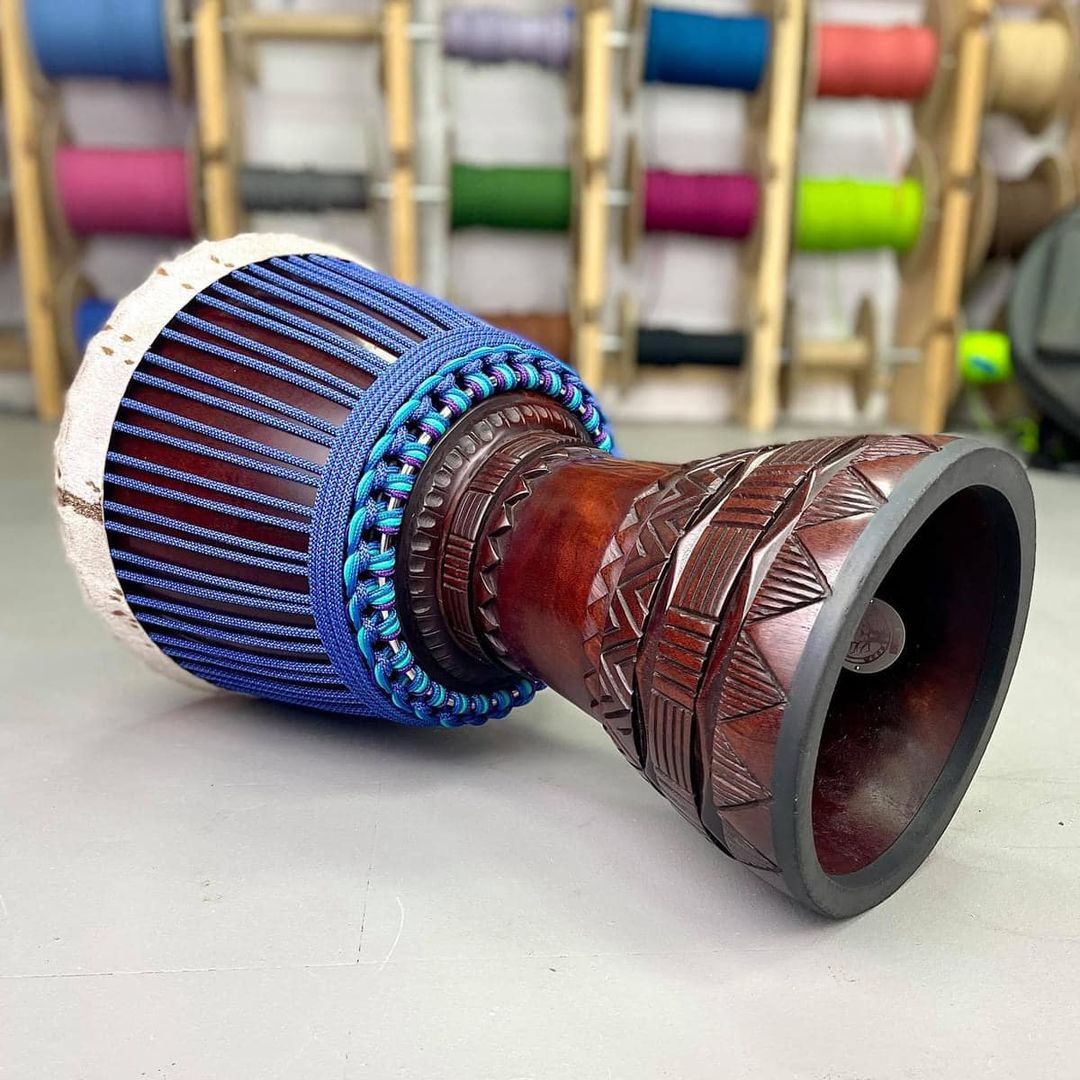
There are other drums being made in neighbouring countries as well as all over the world. You can find a djembe made almost any where in the world now.
Many drums are being massed produced and many drums are being made on machines called lathes which turn and spin the drum making production faster and more efficient. Sometimes in Ghana, the Ivory Coast and even now in Mali and many other places that has replaced hand carving on the interior of shells which also affects the sound.
They can produce more drums faster, but many people feel this is detrimental to the sound yours truly included. Indonesian drums made from plantation grown Mahogany and Mango wood are all made on lathes, I have seen it first hand in Bali.
No matter where a drum is made, the wood needs to have been kept and aged correctly over a certain amount of time. If it has been treated properly chances are it will not crack. Often in cheap drums the wood is too new (fresh) and your drum can crack quickly. Also on cheaper drums, especially Indonesian, the wood is heated to dry in a kiln.
Out of Round? No problem!
We are seeing more and more drums that are not perfectly round anymore. It used to happen over time but now it happens even when the drum is new. This can be happening from a variety of factors and reasons. Some include the wood not being dry, or more likely from the fact that modern djembe drums are being pulled higher and tighter than they were ever pulled in the past. And people are using thicker skins, to get that full tome sound. So there is much, much more pressure on the diameter of the wooden bowl and it goes out of round.
I would like to say, some of my favorite drums I have own, played and seen that are oval or egg shaped have been some of the nicest sounding drums I have played. And it happens less with the heavier drums and thicker shells. So if you want a drum that’s cranked up high, with a thick skin and light weight there is a strong chance it will go out of round at some point.
Large drums are becoming more and more rare and it’s important that the drum makers and companies we support also get involved in programs of replanting and re growth. The wood sources have come from further and further out and it is definitely going to be a problem in the future.
If you are going to buy a drum on line I suggest the companies listed below all of which I have had a lot of experience with. I can not comment on the other companies I have not dealt with or drums I have not seen or played in person. There sure are a lot of people making drums and a lot of excellent photos!
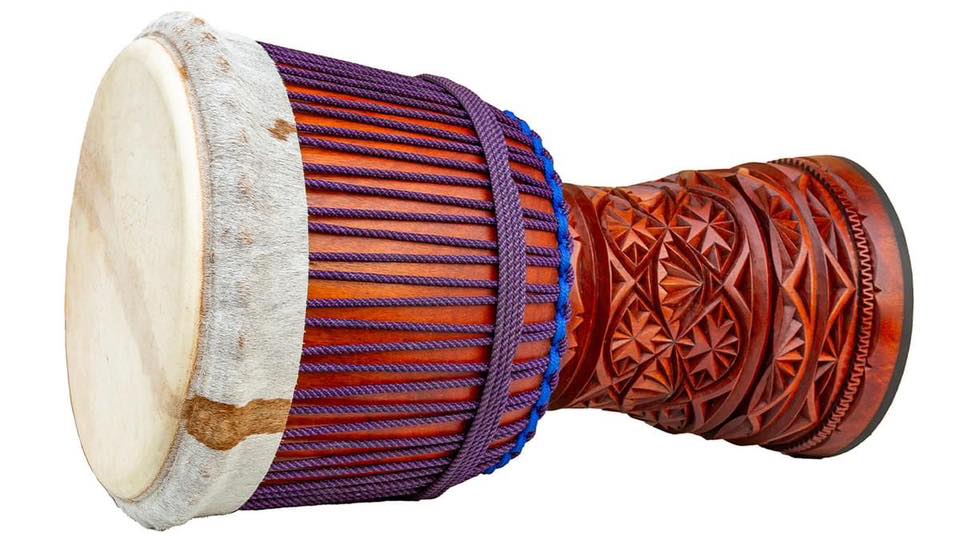
Skins
No matter what the wood is, no mater what the weight of the drum is, no matter what the shell or shape of the drum is the skin must be matched to balance the drums inherent qualities and tonalities.
If you have a very resonant drum shell for example you need to have a certain type of skin to balance and smooth out the sound yet you dont want to kill it.
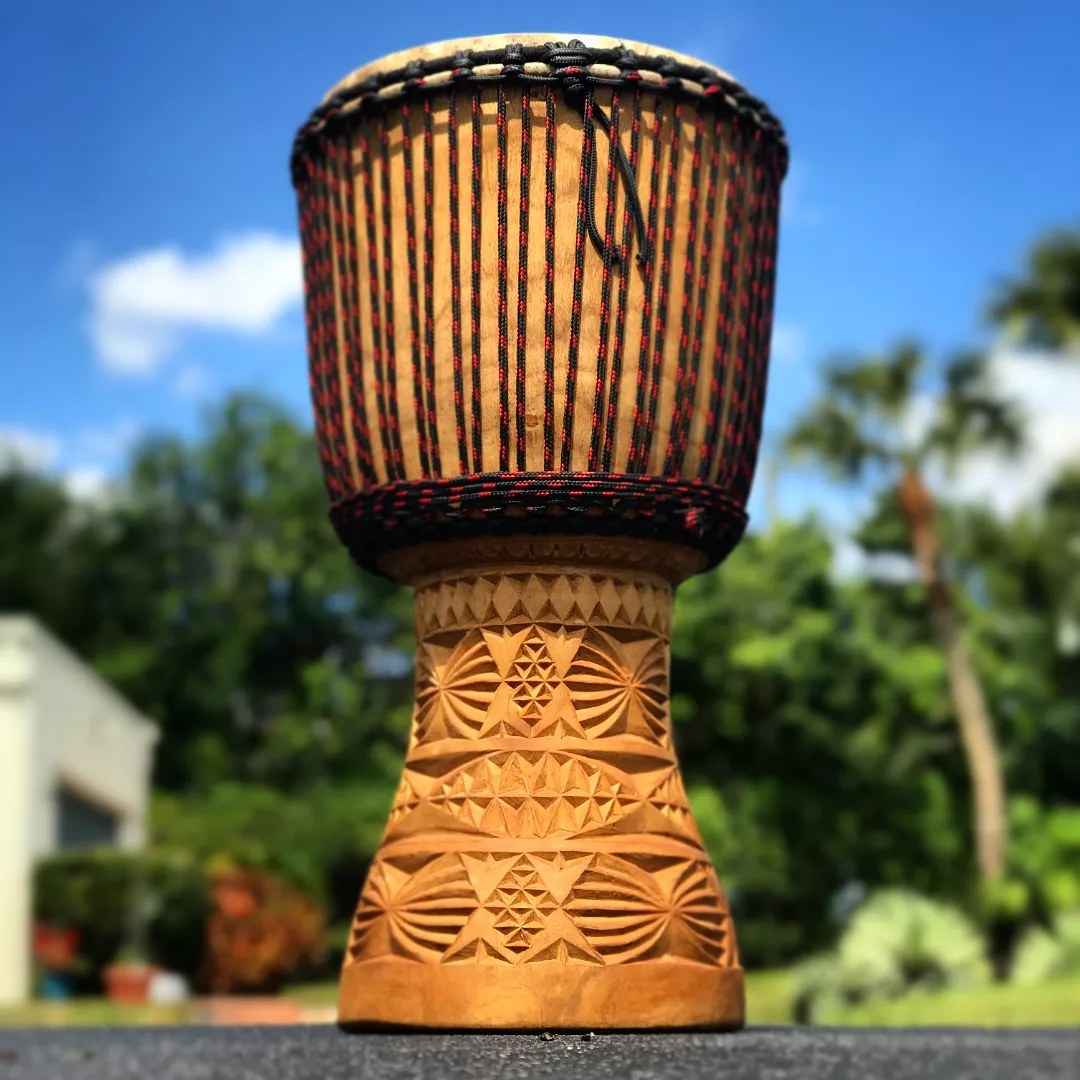
Some drums need thicker skins and some need thinner skins. It’s not ever one skin for all drums. The type of skin matters as well as the thickness.
There is goat skin, calf skin, mule skin, buffalo, horse and camel. Not only does the thickness of all these matter but how the skin was processed plays into your drums sound as an end result as well.
I love the calf skin sound but calf skin is harder on your hands, fingers and joints. It’s a very full melodic tone and musical slap but your body will pay the price. Goat skin when medium to thick is my favourite on many drums. There is a reason the older masters play goat skin and not the tougher alternative skins. Ask them if you see them, they will tell you. It’s about longevity!
Thick goat can sound almost as good melodically speaking as cow. Cow has a longer life then goat and will not pop in humid climates as easily as goat does. It also stays int one longer with out having to pull the diamonds tighter or higher.
I have left cow or calf skin tunes drums alone for very long periods of time, through hot and cold weather in storage and when I took the drum out it still sounded fantastic. I don’t suggest you do this of course, but it will outlast goat if that is a consideration. And also better for humid climates as is Mylar or plastic.
Plastic will never sound as good as real skin but if you live where it rains all the time like I do it is a great back up drum choice if you play outside constantly. My mylar skinned Mali Lenke drum has saved me several times. You can get a custom made mylar skin drum from Djembe life drums or Motherland Music in LA, California.

I also like mule skin as an in between goat and calf alternative but it tends to hurt ones hands after a while as well. If you have really strong thick skinned hands it may not matter but the rest of us need to be careful.
A good drum maker knows how to pick high quality skins that will both match and enhance the drum perfectly. You want someone with a lot of experience putting your drum together.
High quality skins are important. Not only do they sound better but they last longer as well. They cost more but they are worth it.
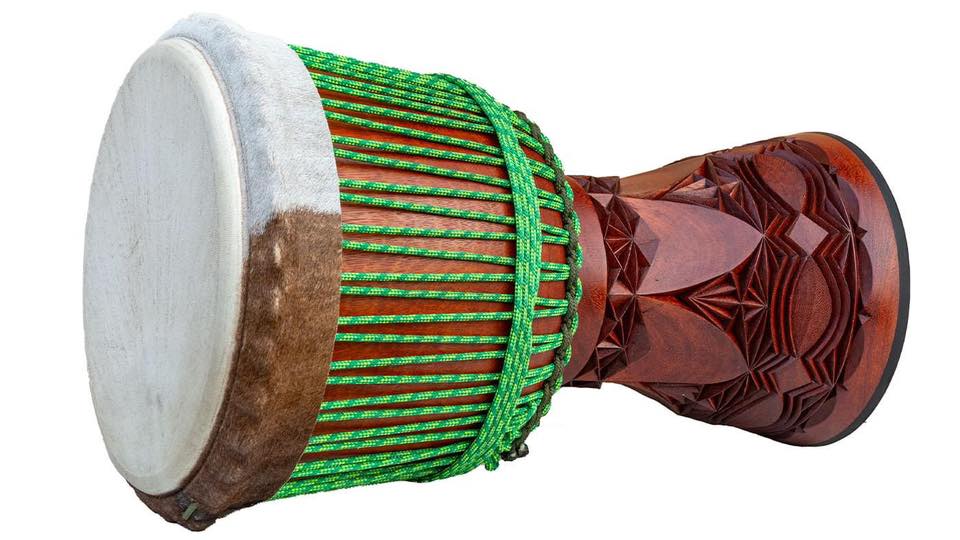
Size matters
The next factor is the size of the drum. The larger the drum the more sound you are going to get. If you are a player with larger hands and you are first starting out on djembe you dont want to start on a small 12″ djembe.
Once you have your technique perfected you can play on anything and make anything sound good as well. You want the drum to fit your body type. Smaller drum for smaller people larger for larger. But not always. Of course its up to you and these are just my suggestions.
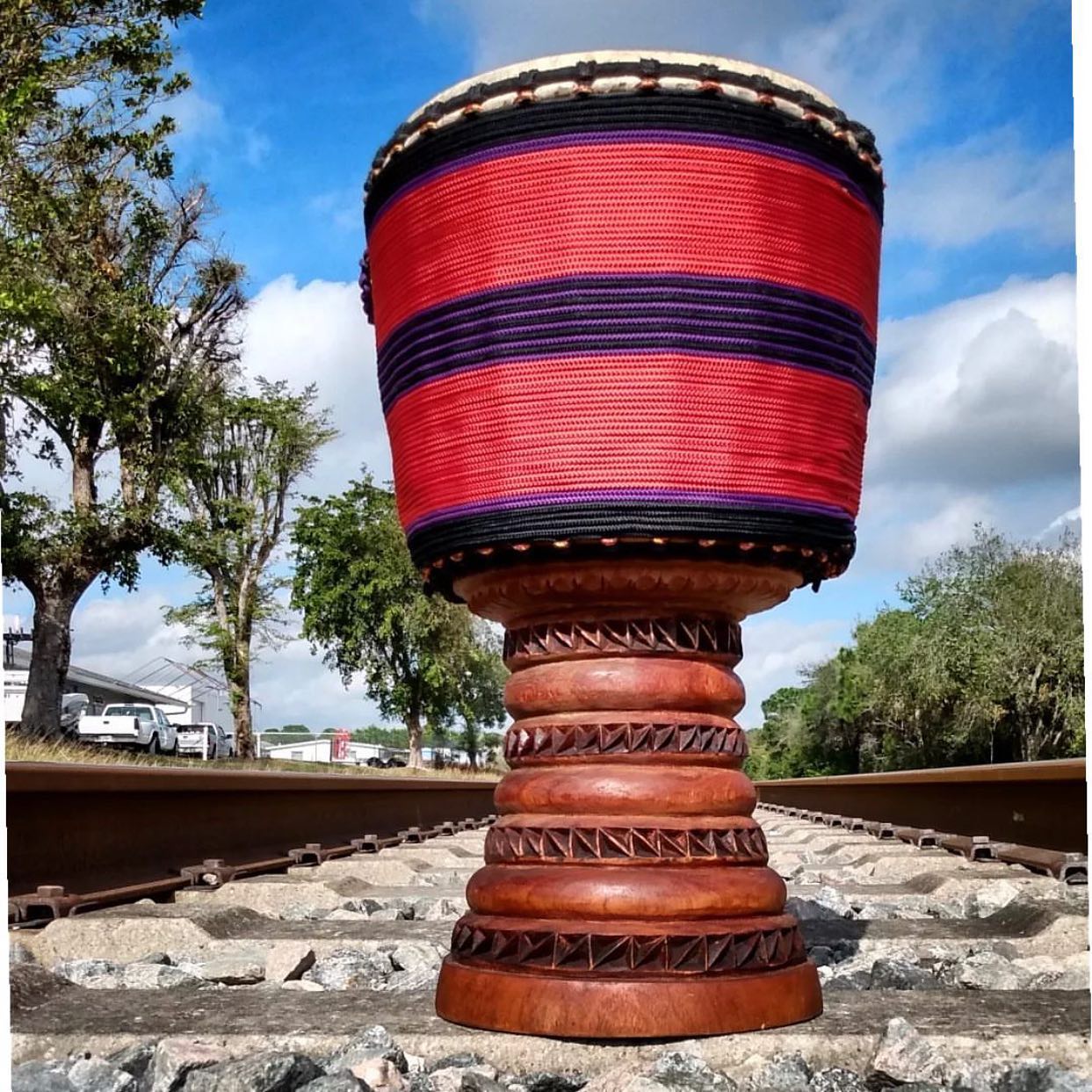
Smaller drums are generally higher pitched where as larger drums have more bass. This can be changed or balanced with how you tune the drum (pulling the ropes) as well.
Higher pitched small drums can be great for soloing but do not offer the full range of sound larger drums do. For inexperienced players it is harder to hold accompaniment on a smaller drum then a larger drum for example.
The shape of the drum, how the upper portion and lower portion is carved can make a huge difference in sound.
The eveness or unevenness of the carving can make a difference in sound although i have heard drums that look awful sound great with the right skins on them.
Weight
As I already mentioned, when buying a drum weight is an important consideration. For me, the heavier the drum and denser the wood the better it sounds. There is just something about the sound of a heavy drum that a lighter drum just can’t get, unless of course you are a master drummer in which case anything you touch sounds good!
However, heavy can be very impractical. Just like trying to park a giant SUV, carrying around a heavy djembe, like 32 lbs can become tiresome and cumbersome.
Used drum?
If you are on a limited budget for the foreseeable future an option is drum that has been repaired. A repaired djembe or one with a head replacement is fine to buy. Often the high end djembe makers sell repaired drums at a signifigant discount.

Instead of buying a new cheap drum with poor sound I highly recommend checking out high end drums that have had crack repairs done correctly or drums that might be slightly out of round.
The slightly out of round drums makes no difference on your sound. And for many people they sound better. Why, who knows. I dont know.
What is your budget?
You get what you pay for. If you buy a $100 drum from Bali or China or Ghana generally the ropes are going to be low quality as well as the skin, the ring, the wood, the carving, the interior and the shape.
It’s all going to be cheap. It might look similar to a more expensive drum but they are not the same thing. There is no substitute for craftsmanship, quality and experience.
Try to get the best drum you can possibly buy even if you are just starting out. Otherwise, you are going to end up being unhappy a few moths down the road. Then when you try to sell the cheap drum you won’t be able to. I suggest going to drum companies such as Koma Drum, Djembe Life, Lucid Drum and others listed below.
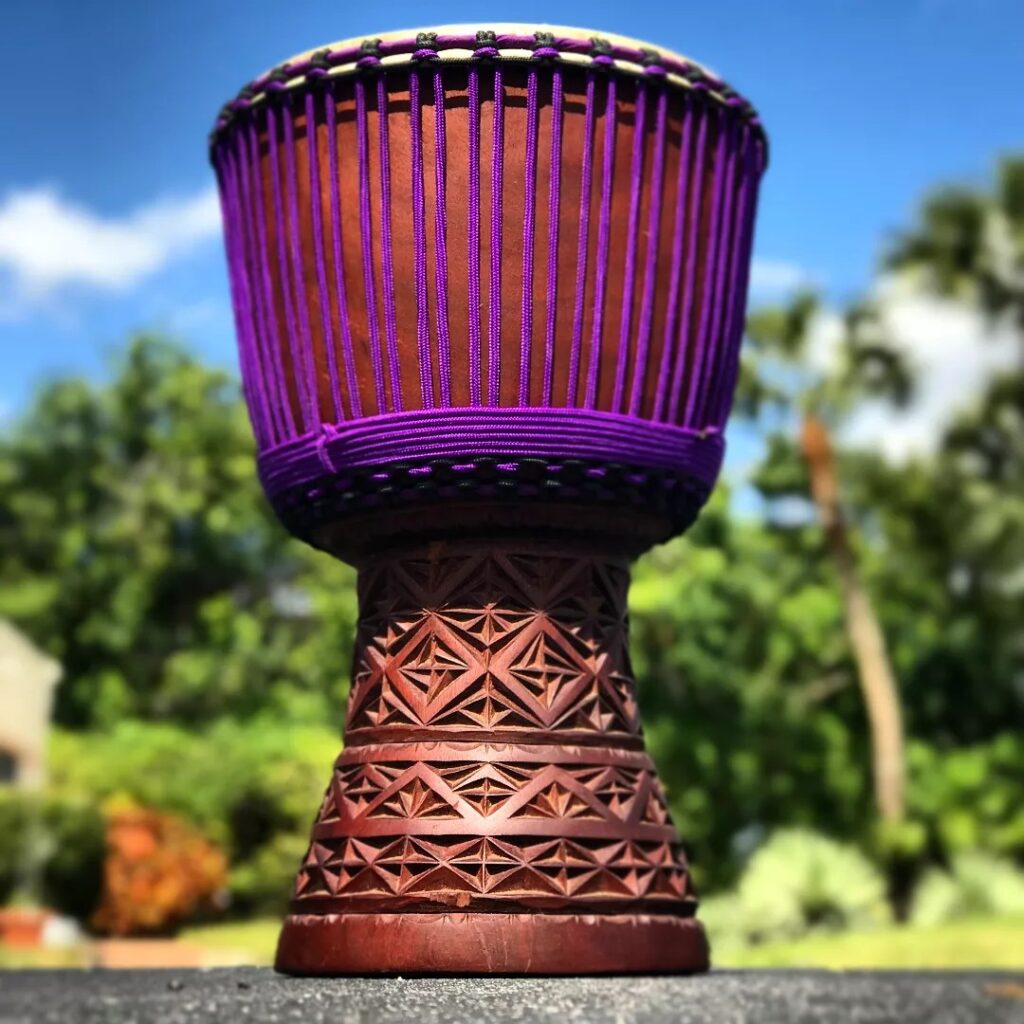
With the reputable companies I will list below, if you order a drum and are unhappy with the drum, you can usually send it back and trade out for another one. They stand behind their product. There is a person who answers the phone and you can talk to.
If you can not see and try a drum personal then you are taking a chance buying it on line. But, this can be totally acceptable and fine!
I always suggest getting a sound demo otherwise known as a sound check. It does not need to be done by a master drummer. It’s great to hear what your drum or any drum you are interested in sounds like. And be sure to use good headphones when you listen. Your phone speaker is not going to cut it to hear a drums sound!
It’s great to go with an older company like Koma Drum, Drum Skull Drums, Wooden Roots, Wassoulou Percussions and Wula Drums to name a few. There are also great independent artisans like David Hernandez at Djembe Life Drums in Florida, Mosheh Milon Sr. in Oakland , California or Lucid Drums by AJ Agostino in Ohio.
Decorative Carvings or Plain?
Djembe drums come in a diverse array of styles, shapes, and sizes, each offering unique aesthetic qualities and characteristics. When it comes to exterior decoration, some djembes feature minimal or even no carving, while others are crafted with intricate designs adorning both the bowl and stem. It’s important to note that these decorative elements do not influence the drum’s sound quality; rather, they reflect the personal preferences of the buyer. Naturally, more elaborately carved drums require a greater investment of time and craftsmanship, which typically results in a higher price tag.
In addition to carvings, many djembe enthusiasts enjoy ordering and customizing their drums with decorative features, such as colorful rope patterns that weave over the vertical tuning ropes in a horizontal fashion. While I personally appreciate the visual appeal of these embellishments, I find them impractical for my purposes.
This is primarily because tuning the drum necessitates the complete removal of the decorative rope, and invariably, I struggle to reattach it in the same way it was originally configured.
Furthermore, there are numerous options to enhance the drum’s appearance through its ropes and knots. Some artists and players even incorporate metal accents or tacks to add a distinctive touch. Ultimately, the possibilities for customization are vast; your imagination and budget are the only limits when it comes to designing a djembe drum that truly reflects your personal style.
This is a Bougarabou drum by Koma Drums!
